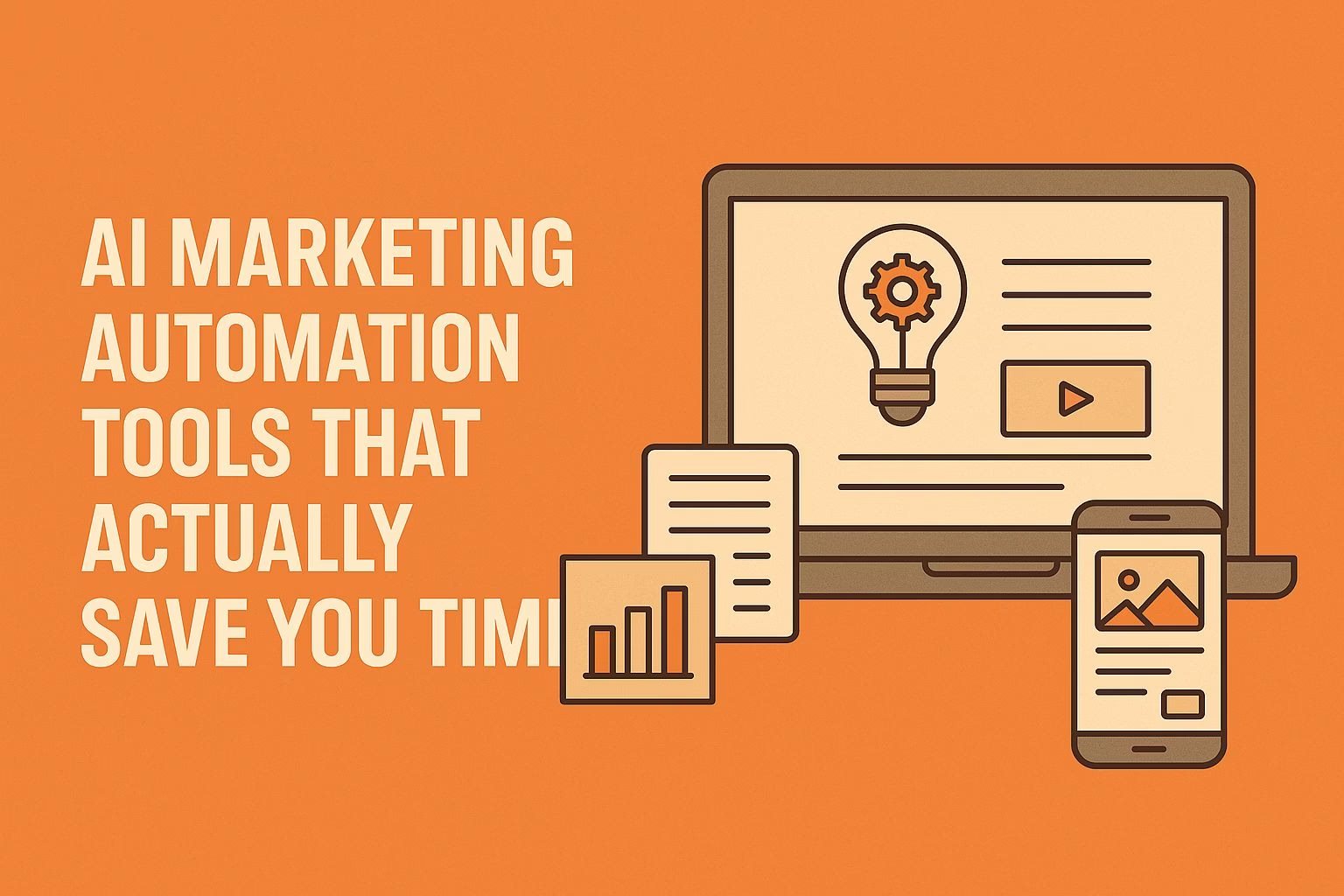AI Marketing Automation Tools That Actually Save You Time
Key Takeaways
- Most marketing automation tools are just schedulers; they don’t remove the workload.
- Consistency matters more than creativity for long-term growth.
- Agencies are expensive and often generic, while AI tools adapt in real time.
- Blaze Autopilot scans your site, builds your brand kit, and posts on autopilot.
- AI loops make content smarter over time, compounding growth without extra effort.
- The best strategy is hybrid: AI handles consistency, humans focus on strategy.
- For entrepreneurs, AI isn’t just about marketing; it’s the shortcut to more freedom.
Running a business today feels like juggling with one hand tied behind your back.
There’s the constant push to stay visible online, post consistently, and keep customers engaged, all while trying to handle the core work that actually makes money.
Most entrepreneurs end up in the same cycle: spending hours on marketing, only to realize it’s still not enough.
The search for shortcuts often leads to two disappointing paths.
On one side, there are agencies that promise results but drain your budget faster than they deliver leads. On the other side, there are cheap automation tools that churn out bland, cookie-cutter posts that do nothing for your brand.
Neither path is sustainable.
That’s where AI-driven marketing automation tools come in. These tools don’t just schedule content; they learn, adapt, and take the heavy lifting off your plate.
In this guide, we’ll break down:
-
Which types of marketing tasks can realistically be automated with AI
-
The tools that actually save time instead of creating more work
-
How one option goes beyond posting to run entire marketing loops for you
You’ll know which tools are worth using and how to keep your marketing running even when you’re not at your desk.
The Problem With Most Marketing Automation
Most tools labeled as “marketing automation” are really just schedulers in disguise. They’ll let you queue up posts for the week, but you still need to create every piece of content yourself.
That means writing captions, designing images, and tracking performance. Instead of removing the workload, these tools simply reorganize it.
The bigger issue is how generic the output becomes when businesses try to cut corners.
A small business owner might grab prewritten templates or copy-paste content, hoping consistency will do the trick.
What actually happens is the audience scrolls past without noticing. The content looks like it came from a factory, not a real brand. That’s a fast track to losing credibility.
Marketing agencies present themselves as the solution to this problem, but they come with their own set of challenges. They’re expensive, often out of reach for small businesses, and they don’t always understand your brand as well as you do.
You end up paying thousands per month for results that are hard to measure and campaigns that still need your oversight.
This gap, between tools that don’t do enough and agencies that do too much for too much money, is exactly why many businesses get stuck.
They need automation that actually thinks, not just software that moves posts around.
Where AI Actually Helps
AI starts making sense when it moves beyond scheduling and into decision-making.
A good AI marketing tool doesn’t just publish content; it studies what resonates, adapts over time, and creates a loop where your best-performing content becomes the template for future posts.
That’s a very different outcome from setting up a one-size-fits-all calendar.
The real time-savings happen when AI handles repetitive creative tasks. Think about writing captions in your brand voice, generating images that fit your color scheme, or even pulling insights from past posts to guide future ones.
Each of these steps eats away at your day when you’re doing them manually. With AI, those tasks shrink down to a few minutes of setup followed by ongoing automation.
Some tools focus narrowly, like just helping with social media captions or image generation.
Others aim to cover the whole funnel, from social posts to blog articles and newsletters. Blaze Autopilot fits into that second group.
Instead of being a single-purpose assistant, it builds a full cycle: scans your site, creates a brand kit, generates content, and keeps refining based on what actually converts.
When used this way, AI doesn’t just save time; it compounds results. Every post feeds data back into the system, so the next post is better.
That’s where businesses start to see growth that feels organic, even though it’s powered by automation.
How Consistency Beats Creativity
Most business owners pour energy into trying to come up with something new every time they post.
The problem is, one clever campaign won’t build momentum if the posting schedule is inconsistent. Social platforms reward brands that show up regularly.
That means consistency often outweighs bursts of creativity when it comes to long-term growth.
Think about the last time you followed a brand. Chances are, it wasn’t because of one viral post; it was because you kept seeing them appear in your feed.
Over time, repeated exposure builds trust. If you disappear for a few weeks, that trust erodes, and you need to start over to rebuild attention.
This is where automation has the biggest impact. An AI system can ensure that your brand shows up day after day, even when you’re busy running the actual business.
With Blaze Autopilot, for example, the learning loop doesn’t just keep content flowing. It adjusts based on what gets clicks and engagement, so the consistency isn’t just frequent, it’s effective.
When consistency is handled for you, you free yourself from the pressure of always being “on.”
That gives you room to be more creative when inspiration strikes, instead of treating creativity like an exhausting daily obligation.
Why Agencies Can’t Compete With AI
For years, marketing agencies had the advantage because they could dedicate teams of people to a client’s brand. The trade-off was cost.
A single campaign could run thousands of dollars, and many small businesses simply accepted that marketing was an expensive overhead. AI changes that equation.
An AI-driven tool doesn’t need holidays, sleep, or endless back-and-forth approvals. It learns your brand once, then applies that knowledge across every channel.
Blaze Autopilot takes this further by building your brand kit, maintaining your style, and scaling output at a fraction of agency pricing. It’s not just cheaper, it’s faster, more adaptive, and available at any time.
Agencies often recycle strategies across clients, which leads to the same problem as cookie-cutter automation tools: generic content.
An AI system focused entirely on your data avoids that trap. It studies what your audience actually clicks on, doubling down on real performance rather than relying on broad assumptions.
The bottom line is that AI isn’t just competing with agencies; it’s replacing the need for them in many cases. Businesses that would have spent their budget outsourcing now get the same (or better) results at a fraction of the cost.
That shift is already happening, and it’s only accelerating.
Posting More Without Spending More Time
The biggest challenge for most small businesses isn’t knowing what to post; it’s having the time to do it consistently.
Writing captions, designing graphics, and scheduling across multiple platforms can easily eat up five to ten hours a week. That’s time most business owners don’t have.
AI tools change that equation by automating the heavy lifting. Instead of manually drafting every post, you can set up a system that creates content, matches your brand style, and pushes it live while you focus on operations.
Blaze Autopilot, for instance, builds an entire strategy from your website and keeps publishing without you having to check in daily.
The key is scalability. Posting once a week doesn’t move the needle, but posting multiple times across different platforms does.
Without automation, scaling output means burning yourself out or hiring more staff. With automation, scaling is just a matter of setup.
What AI Loops Mean for Long-Term Growth
Traditional marketing campaigns are static. You plan content, run it for a few weeks, then look at the results and decide what to change.
That lag means you’re always reacting instead of adapting in real time. AI flips that model by creating continuous learning loops.
Blaze Autopilot is designed around this principle. It doesn’t just post and move on; it studies engagement data from every piece of content, then adjusts the next round of posts to reflect what worked best.
Over time, your marketing gets sharper, more personalized, and more effective without extra effort from you.
This creates a compounding effect. The first month might feel like a test run, but by month three, the system has already identified which styles, tones, and formats drive the most clicks and sales.
The more you let it run, the smarter it becomes, which means the results grow alongside your business.
Instead of wasting time chasing new strategies or experimenting blindly, the loop turns your actual audience behavior into a roadmap.
That’s not just automation, it’s optimization at a scale most small businesses never had access to before.
AI vs Human Marketing
Hiring people to handle marketing feels like the safer option for many small businesses.
A human team understands nuance, can brainstorm creatively, and offers the reassurance of personal touch. The downside is cost and speed.
A marketing hire can cost thousands per month, and even then, output is limited by how many hours that person can work.
AI flips the equation by handling repetitive creative tasks at scale. It doesn’t get tired, doesn’t need approvals, and doesn’t stall on tight deadlines.
Blaze Autopilot, for example, builds your brand kit once, then applies it across posts, blogs, and newsletters. The output matches your voice, but the speed and volume are far beyond what a human team could deliver at the same price.
This doesn’t mean humans are out of the picture. The best approach is hybrid: let AI handle the bulk of execution while you (or your team) focus on high-level strategy and unique campaigns.
Putting AI in charge of consistency keeps your people free to do the work that truly requires a human touch.
For most small businesses, this hybrid model isn’t just efficient, it’s the only way to scale marketing without breaking the budget.
The Shortcut Most Entrepreneurs Don’t Know About
Entrepreneurs are used to working long hours and wearing multiple hats. Marketing often gets pushed to the bottom of the list, not because it’s unimportant but because it feels impossible to keep up with everything else.
The shortcut most entrepreneurs overlook is that they don’t actually need to do it all themselves.
The rise of AI-driven marketing tools means you can “set it and forget it.” Once the system is running, it creates content, posts regularly, and learns what drives engagement.
Blaze Autopilot is built to be exactly that shortcut: an always-on marketing assistant that works while you sleep.
This kind of automation doesn’t just save time, it creates space. With marketing handled in the background, you can focus on sales, product development, or simply having more hours back in your day.
That’s the real benefit: not just growth, but freedom.
Entrepreneurs don’t need another tool that adds work; they need one that removes it.
AI marketing loops provide that missing piece, and the businesses adopting them now are the ones pulling ahead fastest.

